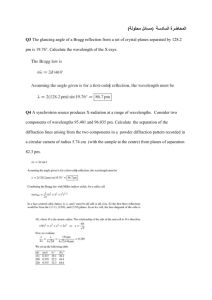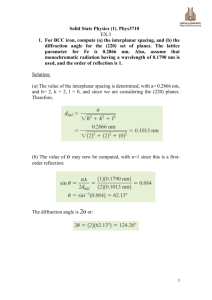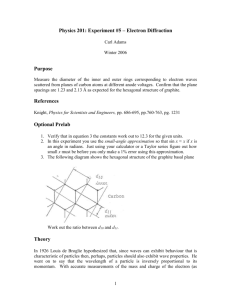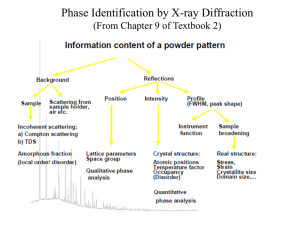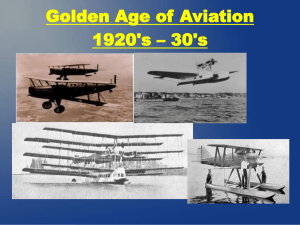ELECTRON DIFFRACTION - Oregon State University
advertisement
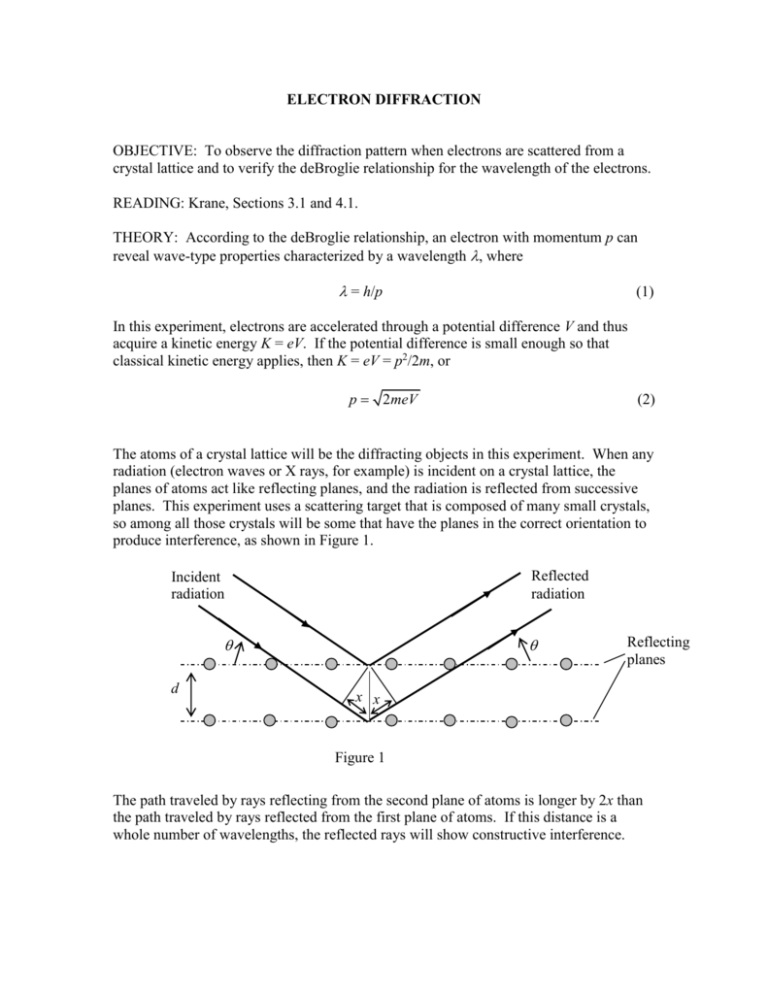
ELECTRON DIFFRACTION OBJECTIVE: To observe the diffraction pattern when electrons are scattered from a crystal lattice and to verify the deBroglie relationship for the wavelength of the electrons. READING: Krane, Sections 3.1 and 4.1. THEORY: According to the deBroglie relationship, an electron with momentum p can reveal wave-type properties characterized by a wavelength , where = h/p (1) In this experiment, electrons are accelerated through a potential difference V and thus acquire a kinetic energy K = eV. If the potential difference is small enough so that classical kinetic energy applies, then K = eV = p2/2m, or p 2meV (2) The atoms of a crystal lattice will be the diffracting objects in this experiment. When any radiation (electron waves or X rays, for example) is incident on a crystal lattice, the planes of atoms act like reflecting planes, and the radiation is reflected from successive planes. This experiment uses a scattering target that is composed of many small crystals, so among all those crystals will be some that have the planes in the correct orientation to produce interference, as shown in Figure 1. Reflected radiation Incident radiation d Reflecting planes x x Figure 1 The path traveled by rays reflecting from the second plane of atoms is longer by 2x than the path traveled by rays reflected from the first plane of atoms. If this distance is a whole number of wavelengths, the reflected rays will show constructive interference. From the geometry of the crystal planes, x = d sin , and so the interference condition is 2d sin n (3) where n = 1,2,3,…In this experiment we will analyze the first-order interference (n = 1). The scattering crystal used for this experiment is graphite, which doesn’t have the regular square array of atoms shown in Figure 1 in its lattice. The lattice geometry of graphite is hexagonal, as shown in Figure 2. d11 Figure 2 d10 There are many possible sets of reflecting plans that can be drawn through the atoms of the graphite lattice. Two prominent sets of planes are called the d10 and d11 planes. From the lattice spacing in graphite, the distances between the reflecting planes are known to be d10 = 0.213 nm and d11 = 0.123 nm. APPARATUS: The apparatus for this experiment consists of an electron diffraction tube along with an external high voltage supply for accelerating the electrons, a filament supply for producing a beam of electrons, and a low-voltage focus adjustment. A schematic diagram of the electron diffraction tube is shown in Figure 3. Figure 3 The focus adjustment applies a bias voltage between the cathode and the cathode can, and the main accelerating voltage is applied between the cathode can and the anode. The anode contains the carbon foil. Electrons from the cathode penetrate the foil and are diffracted to produce a pattern on the screen. In a polycrystalline sample, the interference maxima appear as rings on the screen (see Figures 3.9 and 4.3 in the textbook). Because the screen is round and has a large curvature, it is necessary to do a geometrical analysis to find the relationship between the diffraction angle , the diameter D of the rings, and the radius of curvature R of the screen. Figure 4 shows the geometry. Incident beam Reflected beam Screen R 2 Reflection plane D/2 L Figure 4 From this geometry, we can determine the angle from tan 2 D/2 L R R 2 ( D / 2) 2 (4) For the diffraction tube used in this experiment, L = 14 cm and R = 6.6 cm. PROCEDURE: The procedure in this experiment is to determine from the diffraction rings and then to use the interference condition to find the corresponding wavelength. (This is similar to the way a diffraction grating is used for light – the wavelength can be calculated from the angular position of the interference maxima.) You can then compare that measured value for the wavelength of the electrons with the value expected from the deBroglie relationship. The diffraction rings are diffuse and hard to measure accurately. Therefore use calipers and average 3 separate measurements to get the best value for the ring diameters. When measuring, be sure to look at each side of the ring from a “head-on” position to minimize parallax errors. The accelerating voltage should be varied from 2.5 kV to 5 kV in steps of 0.5 kV. For each voltage setting, adjust the focus to get the clearest set of rings. Adjusting the focus voltage can change the accelerating voltage, so be sure to re-check the accelerating voltage after adjusting the focus and before measuring the ring diameters. ANALYSIS: For each voltage setting, determine the diameter of the two n = 1 rings (the smaller one one corresponding to the d10 spacing and the larger one to the d11 spacing) and determine the reflection angle . Using the appropriate value of the spacing between the reflecting planes, find the two wavelengths. Average the two values. For that accelerating voltage, determine the electron momentum (in eV/c) and the corresponding deBroglie wavelength. Discuss the agreement between the wavelength obtained from the diffraction pattern and the expected deBroglie wavelength of the electron. By combining equations 1 and 2, develop an equation that can be used to produce a linear graph involving and V. Plot your data for the inner and outer rings on 2 separate graphs. From the slope of each graph, obtain a value for Planck’s constant. Estimate the uncertainty in determining D and also consider any other sources of error that may be significant in this experiment. Do your measured and predicted values of the wavelength agree within the estimated error limits? Does your value for Planck’s constant agree with the accepted value within those limits? Discuss any significant discrepancies. QUESTIONS: 1. Why are the d10 and d11 reflecting planes the most important ones for this experiment? Are there other ways that you could draw reflecting planes in Figure 2? Why are these planes less important in this experiment? 2. Why is it not necessary to show the 3rd reflecting plane in Figure 1?
